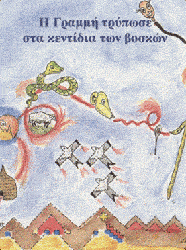 Educational programs archive
Educational programs archive
Sarakatsan Embroideries, 1997, in the Programme ‘MELINA – EDUCATION AND CULTURE’
For children aged 7-8
With minor modifications the programme can be adapted to children aged 6.

Duration: 10-15 days
Location: School. Visits are proposed to the Folklife and Ethnological Museum, the Sarakatsan Museum in Serres or other local societies with collections of Sarakatsan items.
Purpose: acquainting the children with aspects and values of our traditional culture and making them more aware of their cultural heritage
Objectives: Teaching the children about the decorative motifs used in embroidering Sarakatsan clothes, decorating household items and even loaves of bread. These motifs featured above all the square, triangle and circle - so this is a good way of familiarizing the children with these basic geometrical concepts.
The programme is designed on a work plan focusing on Sarakatsan Embroideries and is taught using educational material available at the Museumshop. This includes:
a. student's book ('Following the dotted line in Pastoral Embroideries'),
b. teacher's book (‘Sarakatsan Embroideries'),
c. embroidery material,
d. video with cartoons ('Following the dotted line in Pastoral Embroideries').
Editing-Texts: Foteini Oikonomidou-Botsiou
Illustration: Zisis Skabalis
Adaptation of fairy tales: Egli Brouskou
Music: Yannis Chouliaras
Video: Mangos Salonica (Ν. Giannopoulos, G. Koufonikos, Ch. Sotirakos)
Photographs: Yannis Papanikolaou
A few words about the programme: The line of Sarakatsan design wove its way through the embroidery of the nomadic people, taking on the form of the circle, the square, the triangle and more complex shapes. Outlining suns, moons and crosses it decorated aprons, skirts and other clothing, as well as household items and even loaves of bread. The children follow the decorative line, playing, embroidering, painting, singing, listening to or composing stories. It teaches them about shapes, colours and materials - wool and cotton, wood or dough.
The programme is taught mainly in the classroom. Some of the activities may be covered through a visit to the Museum, after teachers have reached agreement with the Museum staff.
Planning: Foteini Oikonomidou

 Follow us
Follow us 



